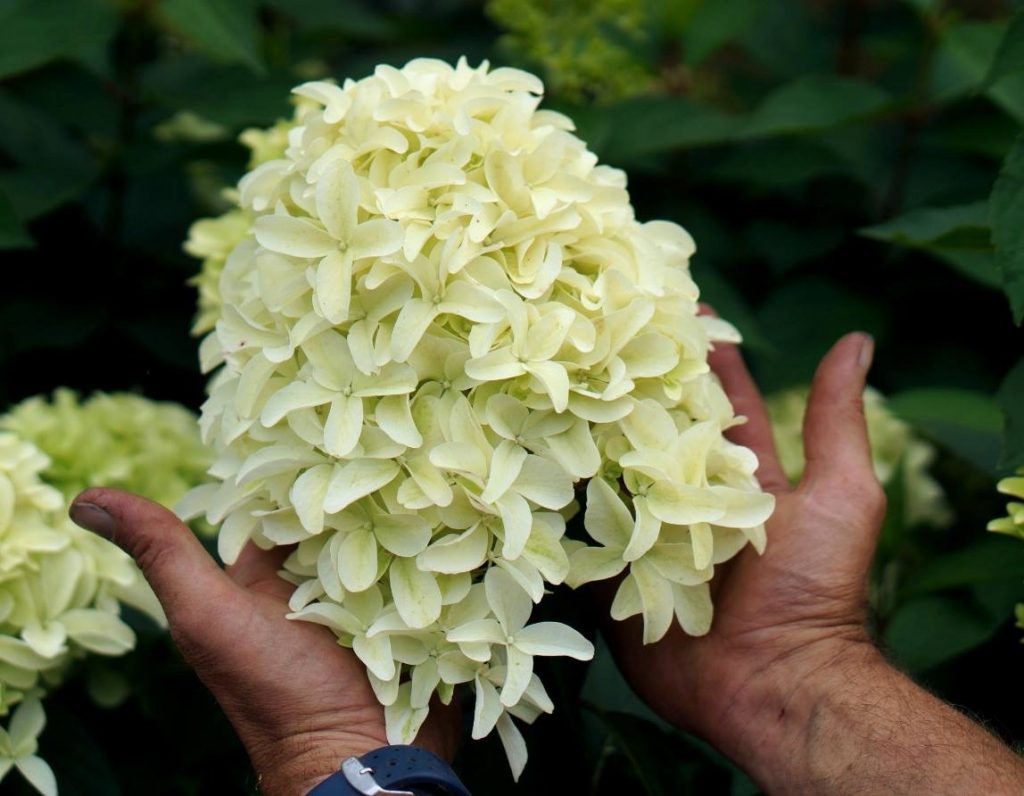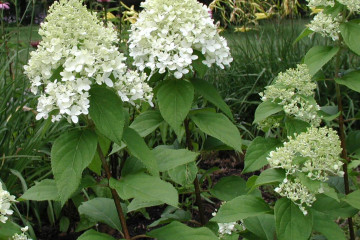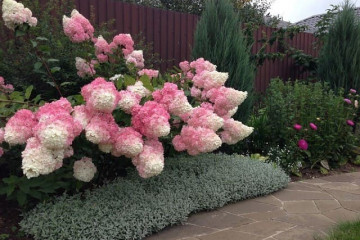Hydrangea Paniculata Skyfall
Content:
For the first time, a wide audience was able to admire a flowering seedling of a panicle hydrangea of the Skyfall variety at the Plantarium International Exhibition in 2018. Its highlight is the unusually large inflorescences, in a fully blossoming state larger than the size of an adult's head.
Description of Skyfall hydrangea
The variety belongs to the paniculate type of hydrangea (Hydrangea Paniculata), which is best suited for cultivation in gardens and flower beds. The ancestors of modern hybrids bloomed from the age of 5, and the newest hybrids, like Skyfall, open their buds already in the third year of life.
The crown can be formed by a tree, leaving the strongest central shoot, and cutting out the minor ones. But much more often the panicle hydrangea is formed by a lush bush with numerous inflorescences. Under their weight, rather thin shoots droop, which requires organizing supports around the crown.
Origin and appearance
As the branches grow, the plant takes the form of a compact bush with vertical strong shoots. Optimal size: 1.2 m - height, 70 cm - width. The variety is suitable for growing in open beds, as well as in tubs and containers. Looks good singly and in a group planting. Prefers semi-shady placement, fertile moist and well-drained soil. Withstands frosts down to -30 ° С.
How the Skyfall hydrangea blooms
In July, the tops of the shoots are covered with buds, which bloom into very large panicles. The size of the inflorescence is more than 30 cm in height, more than 15 cm in width. The shape is conical.
Immediately after blooming, the flowers are pure white or with a slight green tint, gradually gaining a pinkish tone. The flower petals are large. In general, the similarities can be traced both with hyacinth and large-flowered lilacs.
Transplant after purchase in open ground
The optimal time for planting is before bud break or after leaf fall is complete. In a dormant state, the plant tolerates transplantation well. But it is perfectly acceptable to plant a hydrangea in the summer before buds appear at the ends of the young shoots.
What is needed for landing
A place for a seedling is chosen near a shelter that will protect the plant from strong cold winds. Flowerbeds are suitable near the walls of the house, along the fence. Additionally, it is recommended to immediately purchase and install a support around each bush for future lush inflorescences.
Choosing the best place
In addition to the need to protect the bush from the winds, it is important to choose a site where the groundwater level is deeper than 1.5 m. The panicle hydrangea does not tolerate root flooding, for all its love for increased moisture.
Step-by-step planting process
Landing is carried out in the following sequence:
- Dig a planting hole 50 × 50 cm and a depth of at least 50 cm.
- Pour 1-2 buckets of water into it.
- A day later, a drainage layer is made at the bottom of the pit. A large jackdaw, broken brick, expanded clay, small pieces of charcoal will do.
- If several seedlings are planted at once, then a distance of at least 70 cm is maintained between them.
- Prepare the soil for backfill by mixing fertile soil (pH = 5.5) with sand in a 2: 1 ratio. Additionally 40-50 g of superphosphate is added.
- A support is installed at the bottom for tying the cutting.
- Having spread the roots and lowering the seedling into the hole, they are covered with a fertile soil mixture.
- The root collar should be flush with the soil.
- Water the hydrangea abundantly and sprinkle the near-stem circle with mulch from needles, sawdust, chopped grass.
Propagation of hydrangea Skyfall
The panicle type of hydrangea is easily propagated by vegetative methods: cuttings, layering and dividing the bush. A lot of planting material can be obtained from one bush after 1-2 years.
Propagation by cuttings
The best time to cut the cuttings is in the summer before the buds appear. Apical shoots with 2-3 pairs of buds are cut off.
The leaves are cut in half and the cuttings are lowered into water or soil. It usually takes 3-4 weeks for the roots to appear. Landing in open ground is carried out a year later.
Growing from cuttings
Layers are obtained in June from the lower shoots, which are bent to the soil and fixed with wire pins. Sprinkle 2-3 cm of soil on top. At the end of August, the rooted daughter plant can be dug up and transplanted to a permanent place.
Dividing the bush
In early spring, when the soil thaws, the bushes are dug up and divided into 2-3 parts. Each segment is planted in a new place, following the general recommendations for choosing a site and preparing a fertile soil mixture.
Skyfall Hydrangea Care
During the warm season, the bush brings more joy than trouble, for which gardeners around the world love it.
Watering mode
All panicle hydrangeas are extremely hygrophilous. At the same time, they prefer settled soft water. It is best to have a barrel nearby for settling water, from where to take and pour 2-3 buckets under each bush every three days.
Top dressing
In autumn, rotted manure is spread around the bushes. In the spring, while loosening, 40 g of superphosphate are added. In the summer, before budding, it is useful to add a solution of urea (25 g per 10 l of water).
Features of care during the flowering period
Blooming hydrangea is a magnificent sight. Like all ornamental shrubs, attention should be paid to it, carefully cutting off everything that spoils the appearance: faded inflorescences, broken twigs, dry leaves, etc.
Features of care during the rest period
It is this time that is best suited for treatment against pests and diseases. With an interval of two weeks, the bushes are alternately sprayed with solutions of Bordeaux liquid, foundation, acaricidal preparations.
Preparing for winter
Young bushes are recommended to be covered in the fall immediately after the foliage has completely shed. To do this, install arcs or huts from slats, on top of which you can stretch non-woven agrotextiles or carry out dumping from dry foliage mixed with needles.
Easy maintenance and guaranteed excellent flowering for many years are the advantages of the variety. Each bush of Skyfall hydrangea will bring many pleasant moments to its owner. After a year or two, if desired, you can multiply it by decorating free flower beds.




















